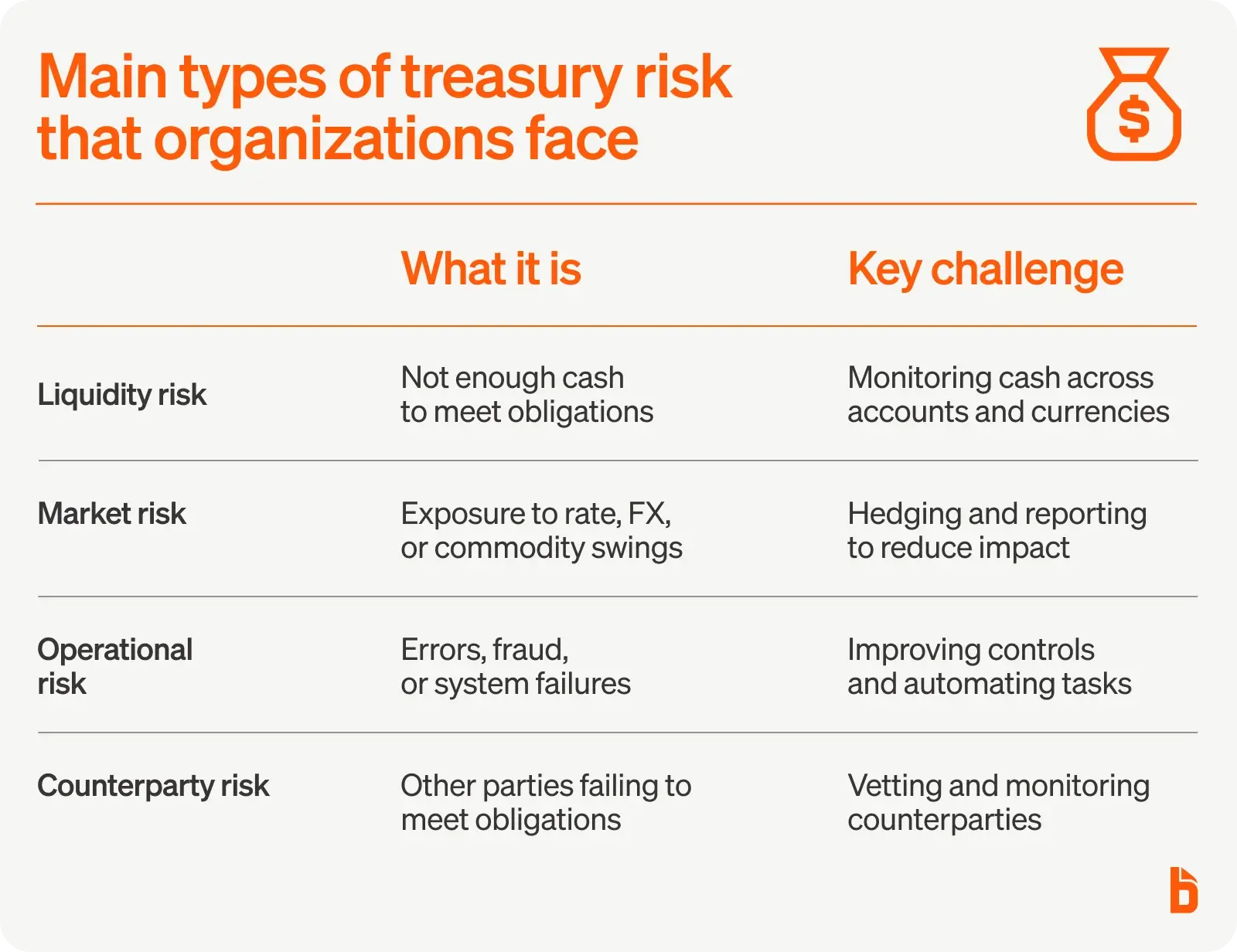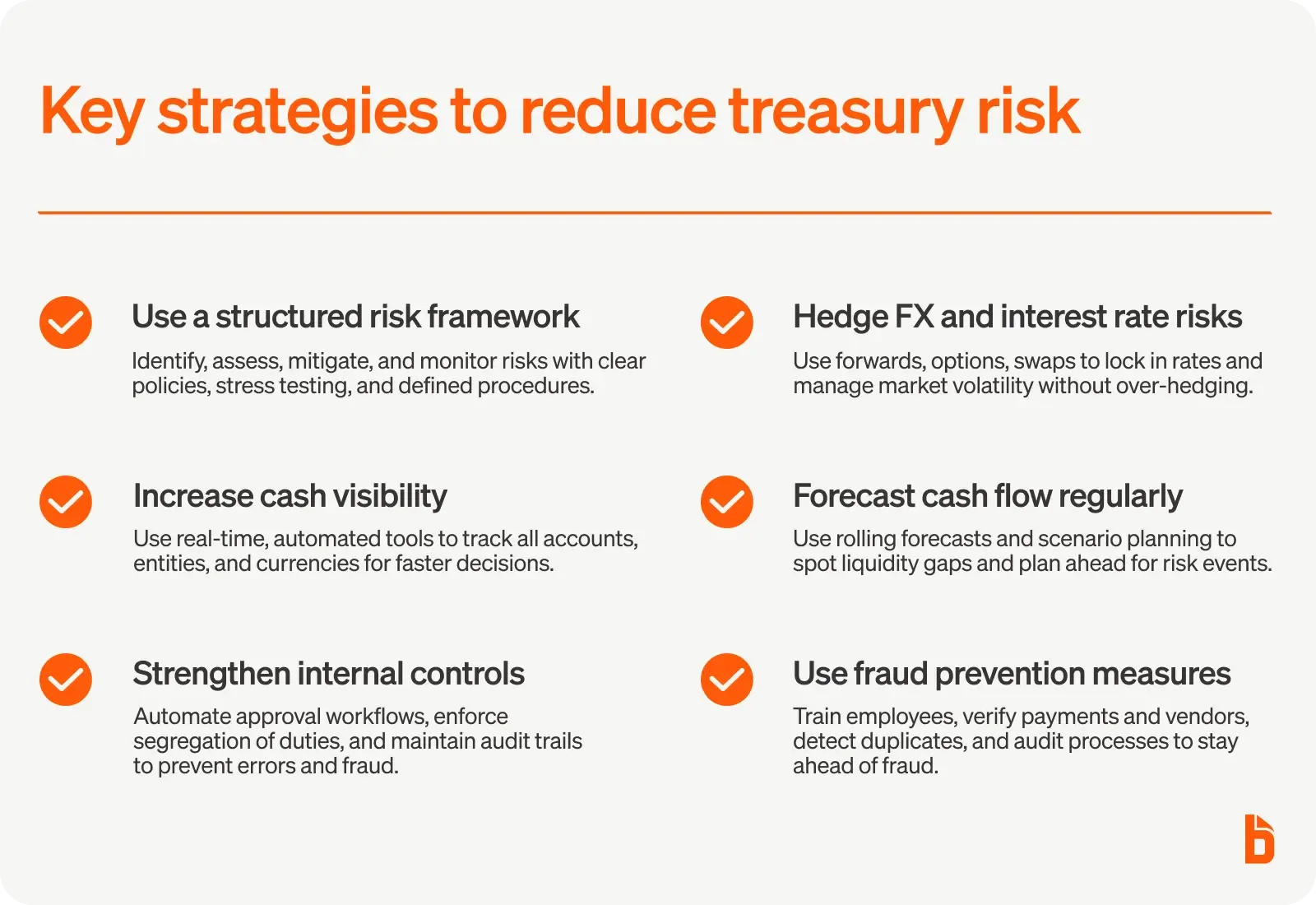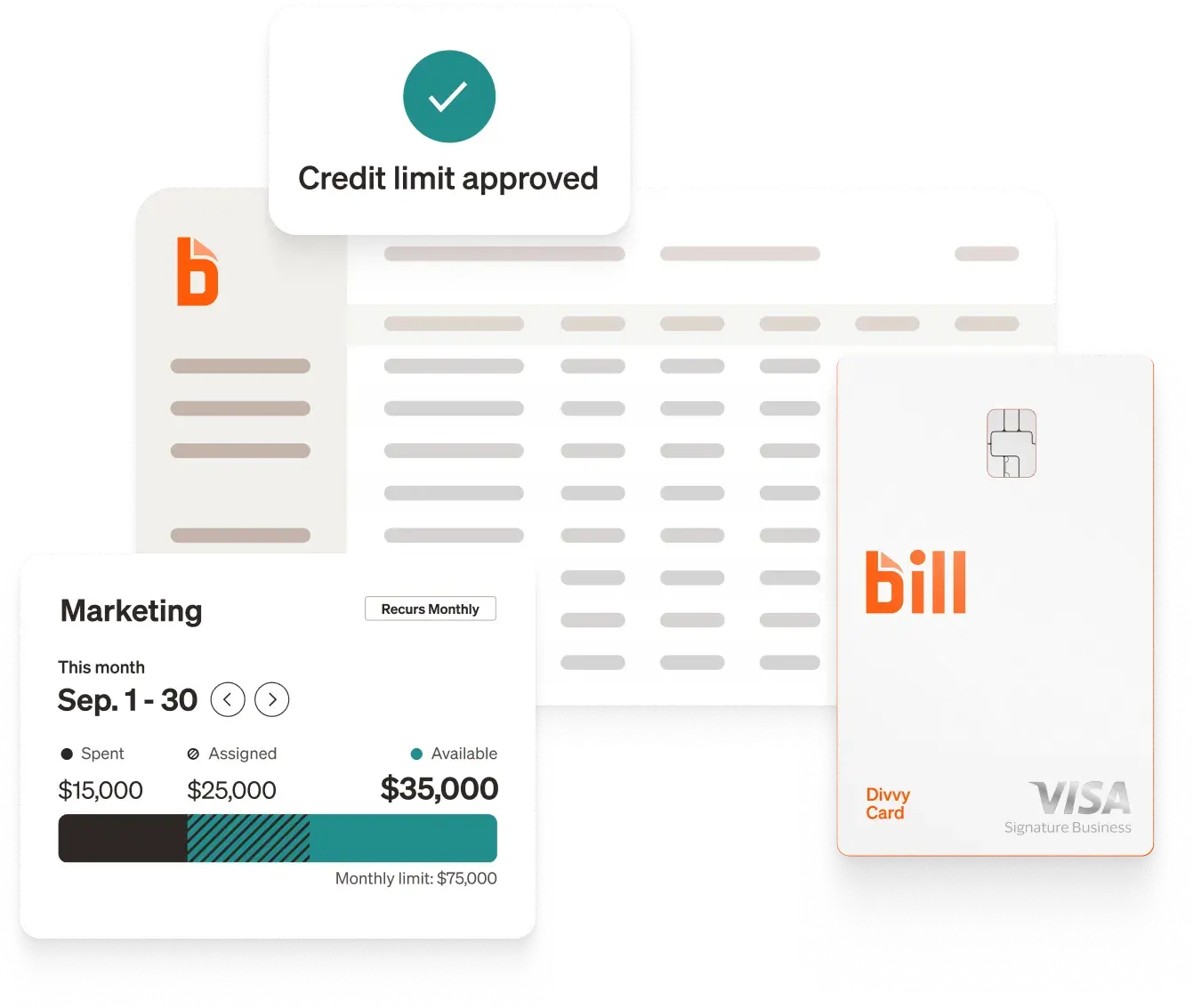Treasury teams are facing mounting pressure to protect organizational assets without compromising operational efficiency, making treasury risk management one of the key pillars of financial stability.
From sudden market shifts to sophisticated fraud attempts, the threats to your organization's financial health are more complex than ever. This post walks through the risks and risk management strategies every treasury team should be aware of.
What is treasury risk management?
Treasury risk management is the systematic approach to identifying, evaluating, and mitigating financial risks that could impact your organization's cash flow, investments, and overall financial stability. It includes everything from managing daily cash positions and financial instruments to protecting against credit risk, currency fluctuations, and fraud.
At its core, treasury risk management aims to safeguard your organization's financial resources, ensuring you have a buffer against future headwinds and the cash you need today to meet financial obligations. This involves creating policies, implementing controls, and using tools that can help predict and prevent financial threats before they materialize.
Modern treasury teams don't just react to risks—they actively monitor market conditions, analyze cash flow patterns, and implement strategies that protect the organization's financial future.

Main types of treasury risk that organizations face
Understanding the different categories of treasury risk is essential for developing comprehensive mitigation strategies. Each of these common risks presents unique business challenges that require specific approaches and controls.
Liquidity risk management
Liquidity risk is the danger of being unable to meet financial obligations when they come due. This fundamental risk affects every organization, regardless of size or industry.
Poor liquidity management can lead to missed payments, damaged vendor relationships, and even insolvency. But ensuring that an organization always has the cash it needs can be a full-time job of continuous monitoring.
The challenge intensifies when organizations operate across multiple entities or currencies. Cash might be available in one account while another faces shortfalls, creating operational friction despite overall financial health.
Market risk reporting
Capital market risk stems from volatility in prices and rates, including commodities, interest rates, and foreign exchange rates. These external factors can dramatically impact your organization's financial position.
Interest rate changes affect borrowing costs and investment returns. Currency fluctuations can erode profits from international operations. Commodity price swings may impact both input costs and revenue streams.
While you can't control market movements, you can implement strategies to minimize their impact on your organization's financial health.
Operational risk assessment
Operational risk encompasses threats from internal processes, people, systems, and unforeseen events like errors, fraud, or natural disasters. These risks often hide in daily routines and manual processes.
Human error in data entry, approval breakdowns, and system failures can all lead to significant financial losses. Manual processes are especially vulnerable, as they lack the built-in controls and audit trails of automated systems.
The complexity of modern treasury operations, with multiple banking relationships and payment methods, can amplify these risks even further.
Counterparty risk identification
Counterparty risk exists whenever other parties might fail to meet their obligations, whether that's a bank holding deposits, a customer that owes you money, or a vendor providing goods and services.
This risk extends beyond simple non-payment. It includes the possibility of paying fraudulent vendors, sending funds to sanctioned entities, or losing deposits in failed financial institutions.
Knowing your counterparties and their level of potential risk requires upfront due diligence as well as ongoing monitoring, especially when the economy is undergoing rapid fluctuations.

Strategies to reduce treasury risk
Successful treasury management requires a multi-layered approach that combines robust treasury processes, enhanced visibility, and proactive monitoring. Many organizations use the following key strategies to manage risk and protect their financial assets.
1. Structured risk management frameworks
A structured risk management framework provides the foundation for all your risk mitigation efforts. The best frameworks embody a continuous, cyclical process: identify risks, assess their potential impact, evaluate mitigation options, implement responses to mitigate risks, and track results.
These treasury systems should include clear procedures for both prevention and risk response when issues arise. Documentation is key, with written policies that define risk tolerance, approval hierarchies, and escalation procedures.
Put your framework through stress testing on a regular basis to make sure it evolves with changing business conditions and emerging threats.
2. Enhanced cash visibility across all accounts
You can't manage what you can't see. Real-time visibility into cash positions across all accounts, entities, and currencies is essential for effective risk management.
Manual cash position reporting is simply too slow and error-prone for a dynamic environment. By the time spreadsheets are updated and circulated, the data is already outdated.
Today's treasury teams use automated solutions that consolidate bank data, providing instant visibility into global cash positions. This real-time information enables proactive decision-making and rapid response to emerging risk issues.
3. Internal controls and approval processes
Robust internal controls are your first line of defense against operational and fraud risks. Every payment should follow defined approval workflows based on amount, vendor type, and purpose.
Segregation of duties ensures no single person can initiate and approve high-value transactions. Multi-level approvals for significant payments add another layer of protection.
Bottom line, automated controls are more reliable than manual ones because they can't be bypassed or forgotten. They also create comprehensive audit trails for compliance and investigation.
4. FX risks and interest rate hedging strategies
Market risks require sophisticated hedging strategies tailored to your organization's specific exposures. Common approaches include forward contracts, options, and natural hedging through operational adjustments.
Forward exchange contracts lock in foreign currency rates for future transactions, eliminating uncertainty. Interest rate swaps can convert variable-rate debt to fixed rates, providing predictable costs.
The key is matching hedging strategies to actual exposures without over-hedging, which can create new risks.
5. Regular cash flow forecasting and scenario planning
Accurate cash flow forecasting helps you anticipate and prepare for potential liquidity challenges. Regular forecasts should incorporate multiple scenarios to test your resilience against various risk events.
Rolling forecasts that extend 13 weeks or more provide early warning of potential cash crunches, and scenario analysis can help you understand how different risk events would impact liquidity.
This forward-looking approach can help your team arrange financing or adjust payment timing before problems materialize.
6. Robust fraud prevention measures
Payment fraud continues to evolve, requiring constant vigilance and multiple defensive layers. Training employees to recognize phishing attempts and social engineering is essential.
On the technical side, controls should include payment verification, duplicate payment detection, and sanctions screening, with vendor verification processes to help prevent payments to fraudulent accounts.
Audit your payment processes regularly to reveal vulnerabilities before criminals exploit them.
Mitigating treasury risk with automation
Automation has become essential for modern treasury professionals, transforming the way organizations protect their financial assets while improving operational efficiency. The right technology can address multiple risk types simultaneously.
How automation reduces operational risk
Automated systems eliminate the manual data entry errors that plague spreadsheet-based processes. They also enforce approval workflows consistently, ensuring every payment follows proper procedures regardless of who initiates it.
Real-time data synchronization between payment systems and your accounting software means information is always current. This eliminates the risk of making decisions based on outdated cash positions, while automated reconciliation catches discrepancies immediately, preventing small errors from becoming major problems.
Strengthening controls through technology
Modern accounts payable automation platforms build controls directly into payment processes. Custom approval rules can route payments based on amount, vendor, department, or any other criteria you define.
Dual control features require two administrators to approve critical changes, preventing both fraud and errors. Single sign-on integration ensures that only authorized users can access sensitive financial systems, and time-stamped audit trails record every action, creating an unalterable record for compliance and investigation.
Real-time visibility and reporting
What treasury team doesn't want real-time visibility and reporting? Automation provides dashboards that show real-time cash positions across all accounts and entities. This immediate visibility enables proactive risk management instead of reactive scrambling.
Customizable alerts notify you of unusual transactions, low balances, or approval bottlenecks, and exception reports highlight payments that deviate from normal patterns, helping you spot potential problems early.
Fraud detection and prevention
When automation combines with AI, it can detect patterns and anomalies that humans might miss, including the ability to flag duplicate invoices, unusual payment amounts, and changes to vendor banking details that could indicate fraud.
Address verification helps confirm vendor legitimacy before processing payments, and integrating your system with sanctions screening services can help ensure you don't inadvertently pay prohibited parties.
These automated checks happen in real-time, stopping fraudulent payments before they leave your accounts.
The strategic value of treasury automation
Beyond risk mitigation, automation frees your treasury team to focus on strategic initiatives. Instead of chasing down approvals and updating spreadsheets, they can analyze cash positions, optimize working capital, and strengthen banking relationships.
This shift from tactical to strategic work can help your treasury function become a competitive advantage rather than just a cost center. The return on investment comes not just from preventing losses, but from better financial decisions enabled by accurate, timely information.








